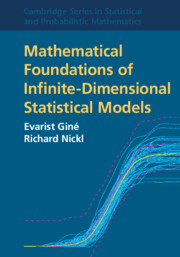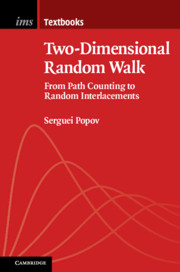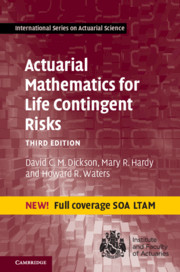Refine search
Actions for selected content:
2703 results in General statistics and probability
2 - Recurrence of two-dimensional simple random walk
-
- Book:
- Two-Dimensional Random Walk
- Published online:
- 09 December 2020
- Print publication:
- 18 March 2021, pp 8-32
-
- Chapter
- Export citation
Contents
-
- Book:
- Two-Dimensional Random Walk
- Published online:
- 09 December 2020
- Print publication:
- 18 March 2021, pp 5-6
-
- Chapter
- Export citation
Index
-
- Book:
- Two-Dimensional Random Walk
- Published online:
- 09 December 2020
- Print publication:
- 18 March 2021, pp 208-209
-
- Chapter
- Export citation
Notation
-
- Book:
- Two-Dimensional Random Walk
- Published online:
- 09 December 2020
- Print publication:
- 18 March 2021, pp 11-14
-
- Chapter
- Export citation

Mathematical Foundations of Infinite-Dimensional Statistical Models
-
- Published online:
- 05 March 2021
- Print publication:
- 25 March 2021

Two-Dimensional Random Walk
- From Path Counting to Random Interlacements
-
- Published online:
- 09 December 2020
- Print publication:
- 18 March 2021

Actuarial Mathematics for Life Contingent Risks
-
- Published online:
- 30 April 2020
- Print publication:
- 19 December 2019
-
- Textbook
- Export citation
10 - Solutions for Chapter 10
-
- Book:
- Solutions Manual for Actuarial Mathematics for Life Contingent Risks
- Print publication:
- 30 April 2020, pp 168-182
-
- Chapter
- Export citation
7 - Solutions for Chapter 7
-
- Book:
- Solutions Manual for Actuarial Mathematics for Life Contingent Risks
- Print publication:
- 30 April 2020, pp 98-125
-
- Chapter
- Export citation
Frontmatter
-
- Book:
- Solutions Manual for Actuarial Mathematics for Life Contingent Risks
- Print publication:
- 30 April 2020, pp i-iv
-
- Chapter
- Export citation
6 - Solutions for Chapter 6
-
- Book:
- Solutions Manual for Actuarial Mathematics for Life Contingent Risks
- Print publication:
- 30 April 2020, pp 77-97
-
- Chapter
- Export citation
13 - Solutions for Chapter 13
-
- Book:
- Solutions Manual for Actuarial Mathematics for Life Contingent Risks
- Print publication:
- 30 April 2020, pp 210-238
-
- Chapter
- Export citation
Contents
-
- Book:
- Solutions Manual for Actuarial Mathematics for Life Contingent Risks
- Print publication:
- 30 April 2020, pp v-vi
-
- Chapter
- Export citation
5 - Solutions for Chapter 5
-
- Book:
- Solutions Manual for Actuarial Mathematics for Life Contingent Risks
- Print publication:
- 30 April 2020, pp 62-76
-
- Chapter
- Export citation
3 - Solutions for Chapter 3
-
- Book:
- Solutions Manual for Actuarial Mathematics for Life Contingent Risks
- Print publication:
- 30 April 2020, pp 24-37
-
- Chapter
- Export citation
1 - Solutions for Chapter 1
-
- Book:
- Solutions Manual for Actuarial Mathematics for Life Contingent Risks
- Print publication:
- 30 April 2020, pp 1-10
-
- Chapter
- Export citation
19 - Solutions for Chapter 19
-
- Book:
- Solutions Manual for Actuarial Mathematics for Life Contingent Risks
- Print publication:
- 30 April 2020, pp 289-296
-
- Chapter
- Export citation
2 - Solutions for Chapter 2
-
- Book:
- Solutions Manual for Actuarial Mathematics for Life Contingent Risks
- Print publication:
- 30 April 2020, pp 11-23
-
- Chapter
- Export citation
8 - Solutions for Chapter 8
-
- Book:
- Solutions Manual for Actuarial Mathematics for Life Contingent Risks
- Print publication:
- 30 April 2020, pp 126-154
-
- Chapter
- Export citation
14 - Solutions for Chapter 14
-
- Book:
- Solutions Manual for Actuarial Mathematics for Life Contingent Risks
- Print publication:
- 30 April 2020, pp 239-247
-
- Chapter
- Export citation
